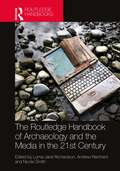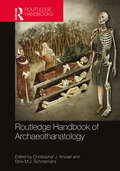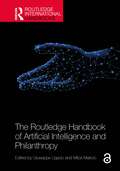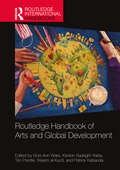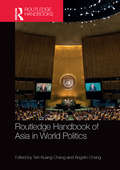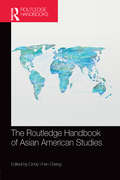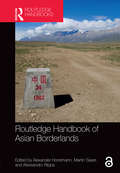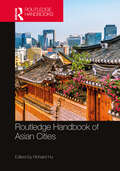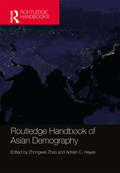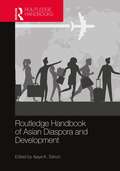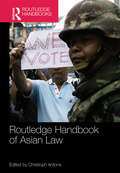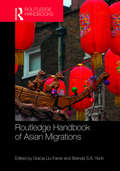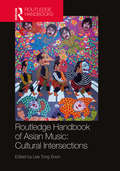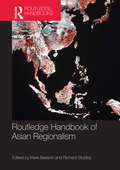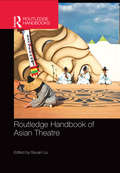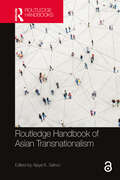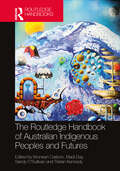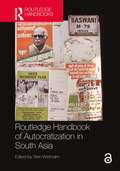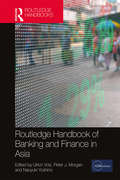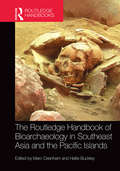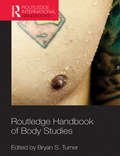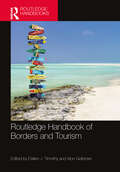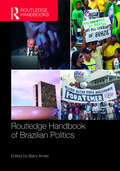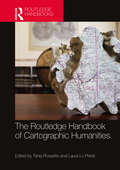- Table View
- List View
The Routledge Handbook of Archaeology and the Media in the 21st Century
by Nicole Smith Andrew Reinhard Lorna-Jane RichardsonThe Routledge Handbook of Archaeology and the Media in the 21st Century presents diverse international perspectives on what it means to be an archaeologist and to conduct archaeological research in the age of digital and mobile media.This volume analyses the present‑day use of new and old media by professional and academic archaeology for leisure, academic study and/or public engagement, and attempts to provide a broad survey of the use of media in a wider global archaeological context. It features work on traditional paper media, radio, podcasting, film, television, contemporary art, photography, video games, mobile technology, 3D image capture, digitization and social media. Themes explored include archaeology and traditional media, archaeology in a digital age, archaeology in a post‑truth era and the future of archaeology. Such comprehensive coverage has not been seen before, and the focus on 21st‑century concerns and media consumption practices provides an innovative and original approach.The Routledge Handbook of Archaeology and the Media in the 21st Century updates the interdisciplinary field of media studies in archaeology and will appeal to students and researchers in multiple fields including contemporary, public, digital, and media archaeology, and heritage studies and management. Television and film producers, writers and presenters of cultural heritage will also benefit from the many entanglements shared here between archaeology and the contemporary media landscape.
The Routledge Handbook of Archaeothanatology: Bioarchaeology of Mortuary Behaviour
by Christopher J. KnüselThe Routledge Handbook of Archaeothanatology spans the gap between archaeology and biological anthropology, the field and laboratory, and between francophone and anglophone funerary archaeological approaches to the remains of the dead and the understanding of societies, past and present. Interest in archaeothanatology has grown considerably in recent years in English-language scholarship. This timely publication moves away from anecdotal case studies to offer syntheses of archaeothanatological approaches with an eye to higher-level inferences about funerary behaviour and its meaning in the past. Written by francophone scholars who have contributed to the development of the field and anglophone scholars inspired by the approach, this volume offers detailed insight into the background and development of archaeothanatology, its theory, methods, applications, and its most recent advances, with a lexicon of related vocabulary. This volume is a key source for archaeo-anthropologists and bioarchaeologists. It will benefit researchers, lecturers, practitioners and students in biological anthropology, archaeology, taphonomy and forensic science. Given the interdisciplinary nature of these disciplines, and the emphasis placed on analysis in situ, this book will also be of interest to specialists in entomology, (micro)biology and soil science.
Routledge Handbook of Art, Science, and Technology Studies
by Hannah Star RogersArt and science work is experiencing a dramatic rise coincident with burgeoning Science and Technology Studies (STS) interest in this area. Science has played the role of muse for the arts, inspiring imaginative reconfigurations of scientific themes and exploring their cultural resonance. Conversely, the arts are often deployed in the service of science communication, illustration, and popularization. STS scholars have sought to resist the instrumentalization of the arts by the sciences, emphasizing studies of theories and practices across disciplines and the distinctive and complementary contributions of each. The manifestation of this commonality of creative and epistemic practices is the emergence of Art, Science, and Technology Studies (ASTS) as the interdisciplinary exploration of art–science.This handbook defines the modes, practices, crucial literature, and research interests of this emerging field. It explores the questions, methodologies, and theoretical implications of scholarship and practice that arise at the intersection of art and STS. Further, ASTS demonstrates how the arts are intervening in STS. Drawing on methods and concepts derived from STS and allied fields including visual studies, performance studies, design studies, science communication, and aesthetics and the knowledge of practicing artists and curators, ASTS is predicated on the capacity to see both art and science as constructions of human knowledge- making. Accordingly, it posits a new analytical vernacular, enabling new ways of seeing, understanding, and thinking critically about the world.This handbook provides scholars and practitioners already familiar with the themes and tensions of art–science with a means of connecting across disciplines. It proposes organizing principles for thinking about art–science across the sciences, social sciences, humanities, and arts. Encounters with art and science become meaningful in relation to practices and materials manifest as perceptual habits, background knowledge, and cultural norms. As the chapters in this handbook demonstrate, a variety of STS tools can be brought to bear on art–science so that systematic research can be conducted on this unique set of knowledge-making practices.
The Routledge Handbook of Artificial Intelligence and Philanthropy (Routledge International Handbooks)
by Giuseppe Ugazio Milos MaricicThe Routledge Handbook of Artificial Intelligence and Philanthropy acts as a catalyst for the dialogue between two ecosystems with much to gain from collaboration: artificial intelligence (AI) and philanthropy. Bringing together leading academics, AI specialists, and philanthropy professionals, it offers a robust academic foundation for studying both how AI can be used and implemented within philanthropy and how philanthropy can guide the future development of AI in a responsible way.The contributors to this Handbook explore various facets of the AI‑philanthropy dynamic, critically assess hurdles to increased AI adoption and integration in philanthropy, map the application of AI within the philanthropic sector, evaluate how philanthropy can and should promote an AI that is ethical, inclusive, and responsible, and identify the landscape of risk strategies for their limitations and/or potential mitigation. These theoretical perspectives are complemented by several case studies that offer a pragmatic perspective on diverse, successful, and effective AI‑philanthropy synergies.As a result, this Handbook stands as a valuable academic reference capable of enriching the interactions of AI and philanthropy, uniting the perspectives of scholars and practitioners, thus building bridges between research and implementation, and setting the foundations for future research endeavors on this topic.The Open Access version of this book, available at http://www.taylorfrancis.com, has been made available under a Creative Commons Attribution-Non Commercial-No Derivatives (CC-BY-NC-ND) 4.0 license.
Routledge Handbook of Arts and Global Development (Routledge International Handbooks)
by Tim Prentki Patrick Kabanda Kirsten Sadeghi-Yekta Vicki-Ann Ware Wasim Al KurdiThis book brings together a leading team of international experts in arts and global development to showcase effective practice and to explore how this vibrant interdisciplinary field has developed and what the latest research can teach us.Although arts play a central role in human development, and in the health and wellbeing of individuals and communities, few have attempted to comprehensively explore arts practice as global development. This Handbook first provides a theoretical framework for exploring arts and global development, before surveying a comprehensive range of art forms and development practices to explore the potential of the arts to strategically and beneficially contribute to more just and equitable conditions for communities across the globe. Stretching across the arts from theatre, dance, and music to poetry, film, and visual arts, the book covers topics as diverse as health, education, peacebuilding, livelihoods, sustainability, activism, and arts as research method in programming. The Handbook also identifies gaps in the literature, pointing towards the most pressing and promising avenues for further research over the next few years.This book will be an essential resource for any researcher, student, or practitioner wishing to understand the role of the arts in global development and in the global south more generally.
Routledge Handbook of Asia in World Politics
by Teh-Kuang Chang and Angelin ChangAsia is a complex and diverse continent, which has seen the scope and pace of transformation increase rapidly over the past 30 years. In turn, the economic growth and social change seen in the region, combined with new global security profiles and environmental challenges, have contributed to placing Asia at the forefront of international affairs. This Handbook brings together leading scholars of different disciplines, including Politics and International Relations, Security Studies and Law, to provide a comprehensive analysis of both the prospects and problems which have emerged from Asia’s rise. Examining how developments across the continent have influenced global politics and how the region has responded to the international community in the modern era, the sections cover: Major actors in Asian politics, especially China, Japan and India, International relations in Asia and intra-Asian tensions Special issues of world politics in Asia including modern conflicts in and attitudes towards the Middle East The Routledge Handbook of Asia in World Politics will be useful to students and scholars of Global Politics, International Relations and Asian Studies.
The Routledge Handbook of Asian American Studies
by Cindy I-Fen ChengThe Routledge Handbook of Asian American Studies brings together leading scholars and scholarship to capture the state of the field of Asian American Studies, as a generation of researchers have expanded the field with new paradigms and methodological tools. Inviting readers to consider new understandings of the historical work done in the past decades and the place of Asian Americans in a larger global context, this ground-breaking volume illuminates how research in the field of Asian American Studies has progressed. Previous work in the field has focused on establishing a place for Asian Americans within American history. This volume engages more contemporary research, which draws on new archives, art, literature, film, and music, to examine how Asian Americans are redefining their national identities, and to show how race interacts with gender, sexuality, class, and the built environment, to reveal the diversity of the United States. Organized into five parts, and addressing a multitude of interdisciplinary areas of interest to Asian American scholars, it covers: • a reframing of key themes such as transnationality, postcolonialism, and critical race theory • U.S. imperialism and its impact on Asian Americans • war and displacement • the garment industry • Asian Americans and sports • race and the built environment • social change and political participation • and many more themes. Exploring people, practice, politics, and places, this cutting-edge volume brings together the best themes current in Asian American Studies today, and is a vital reference for all researchers in the field.
Routledge Handbook of Asian Borderlands
by Alexander Horstmann Martin Saxer Alessandro RippaIn Asia, where authoritarian-developmental states have proliferated, statehood and social control are heavily contested in borderland spaces. As a result, in the post-Cold War world, borders have not only redefined Asian incomes and mobilities, they have also rekindled neighbouring relations and raised questions about citizenship and security. The contributors to the Routledge Handbook of Asian Borderlands highlight some of these processes taking place at the fringe of the state. Offering an array of comparative perspectives of Asian borders and borderlands in the global context, this handbook is divided into thematic sections, including: Livelihoods, commodities and mobilities Physical land use and agrarian transformations Borders and boundaries of the state and the notion of statelessness Re-conceptualizing trade and the economy in the borderlands The existence and influence of humanitarians, religions, and NGOs The militarization of borderlands Causing us to rethink and fundamentally question some of the categories of state, nation, and the economy, this is an important resource for students and scholars of Asian Studies, Border Studies, Social and Cultural Studies, and Anthropology.
Routledge Handbook of Asian Cities
by Richard HuThis handbook provides the most comprehensive examination of Asian cities—developed and developing, large and small—and their urban development. Investigating the urban challenges and opportunities of cities from every nation in Asia, the handbook engages not only the global cities like Shanghai, Tokyo, Singapore, Seoul, and Mumbai but also less studied cities like Dili, Malé, Bandar Seri Begawan, Kabul, and Pyongyang. The handbook discusses Asian cities in alignment to the United Nations’ New Urban Agenda and Sustainable Development Goals in order to contribute to global policy debates. In doing so, it critically reflects on the development trajectories of Asian cities and imagines an urban future, in Asia and the world, in the post-sustainable, post-global, and post-pandemic era. Presenting 43 chapters of original, insightful research, this book will be of interest to scholars, practitioners, students, and general readers in the fields of urban development, urban policy and planning, urban studies, and Asian studies.
Routledge Handbook of Asian Demography
by Zhongwei Zhao Adrian C. HayesHome to close to 60 per cent of the world’s population, Asia is the largest and by far the most populous continent. It is also extremely diverse, physically and culturally. Asian countries and regions have their own distinctive histories, cultural traditions, religious beliefs and political systems, and they have often pursued different routes to development. Asian populations also present a striking array of demographic characteristics and stages of demographic transition. This handbook is the first to provide a comprehensive study of population change across the whole of Asia. Comprising 28 chapters by more than 40 international experts this handbook examines demographic transitions on the continent, their considerable variations, their causes and consequences, and their relationships with a wide range of social, economic, political and cultural processes. Major topics covered include: population studies and sources of demographic data; historical demography; family planning and fertility decline; sex preferences; mortality changes; causes of death; HIV/AIDS; population distribution and migration; urbanization; marriage and family; human capital and labour force; population ageing; demographic dividends; political demography; population and environment; and Asia’s demographic future. This handbook provides an authoritative and comprehensive reference for researchers, policymakers, academics, students and anyone who is interested in population change in Asia and the world.
Routledge Handbook of Asian Diaspora and Development
by Ajaya K. SahooThis handbook offers an analysis of Asian diaspora and development, and explores the role that immigrants living within diasporic and transnational communities play in the development of their host countries and their homeland. Bringing together an array of interdisciplinary scholars from across the world, the handbook is divided into the following sections: • Development Potential of Asian Diasporas• Diaspora, Homeland, and Development• Gender, Generation, and Identities• Soft Power, Mobilization, and Development• Media, Culture, and Representations. Presenting cutting-edge research on several dimensions of diaspora and development, Routledge Handbook of Asian Diaspora and Development provides a platform for further discussion in the fields of migration studies, diaspora studies, transnational studies, race relations, ethnic studies, gender studies, globalization, Asian studies, and research methods.
Routledge Handbook of Asian Law
by Christoph AntonsThe Routledge Handbook of Asian Law is a cutting-edge and comprehensive resource which surveys the interdisciplinary field of Asian Law. Written by an international team of experts, the chapters within cover issues as diverse as family law and Islamic courts, decentralisation and the revival of traditional forms of law, discourses on the rule of law, human rights, corporate governance and environmental protection The volume is divided into five parts covering: Asia in Law, and the Humanities and Social Sciences; The Political Economy of Law in Asia - Law in the Context of Asian Development; Asian traditions and their transformations; Law, the environment, and access to land and natural resources; People in Asia and their rights. Offering an overview of the full spectrum of Law in Asia, the Handbook is an invaluable resource for academics, researchers, lawyers, graduate and undergraduate students studying this ever-evolving field.
Routledge Handbook of Asian Migrations
by Gracia Liu-Farrer Brenda S.A. YeohHousing more than half of the global population, Asia is a region characterised by increasingly diverse forms of migration and mobility. Offering a wide-ranging overview of the field of Asian migrations, this new handbook therefore seeks to examine and evaluate the flows of movement within Asia, as well as into and out of the continent. Through in-depth analysis of both empirical and theoretical developments in the field, it includes key examples and trends such as British colonialism, Chinese diaspora, labour migration, the movement of women, and recent student migration. Organised into thematic parts, the topics cover: The historical context to migration in Asia Modern Asian migration pathways and characteristics The reconceptualising of migration through Asian experiences Contemporary challenges and controversies in Asian migration practice and policy Contributing to the retheorising of the subject area of international migration from non-western experience, the Routledge Handbook of Asian Migrations will be useful to students and scholars of migration, Asian development and Asian Studies in general.
Routledge Handbook of Asian Music: Cultural Intersections
by Lee Tong SoonThe Routledge Handbook of Asian Music: Cultural Intersections introduces Asian music as a way to ask questions about what happens when cultures converge and how readers may evaluate cultural junctures through expressive forms. The volume’s thirteen original chapters cover musical practices in historical and modern contexts from Central Asia, East Asia, South Asia, and Southeast Asia, including art music traditions, folk music and composition, religious and ritual music, as well as popular music. These chapters showcase the diversity of Asian music, requiring readers to constantly reconsider their understanding of this vibrant and complex area. The book is divided into three sections: Locating meanings Boundaries and difference Cultural flows Contributors to the book offer a multidisciplinary portfolio of methods, ranging from archival research and field ethnography to biographical studies and music analysis. In addition to rich illustrations, numerous samples of notation and sheet music are featured as insightful study resources. Readers are invited to study individuals, music-makers, listeners, and viewers to learn about their concerns, their musical choices, and their lives through a combination of humanistic and social-scientific approaches. Demonstrating how transformative cultural differences can become in intercultural encounters, this book will appeal to students and scholars of musicology, ethnomusicology, and anthropology.
Routledge Handbook of Asian Regionalism
by Mark Beeson Richard StubbsThe Routledge Handbook of Asian Regionalism is a definitive introduction to, and analysis of, the development of regionalism in Asia, including coverage of East Asia, Southeast Asia and South Asia. The contributors engage in a comprehensive exploration of what is arguably the most dynamic and important region in the world. Significantly, this volume addresses the multiple manifestations of regionalism in Asia and is consequently organised thematically under the headings of: conceptualizing the region economic issues political issues strategic issues regional organizations As such, the Handbook presents some of the key elements of the competing interpretations of this important and highly contested topic, giving the reader a chance to evaluate not just where Asian regionalism is going but also how the scholarship on Asian regionalism is analysing these trends and events. This book will be an indispensable resource for students and scholars of Asian politics, international relations and regionalism.
Routledge Handbook of Asian Theatre
by Siyuan LiuRoutledge Handbook of Asian Theatre is an advanced level reference guide which surveys the rich and diverse traditions of classical and contemporary performing arts in Asia, showcasing significant scholarship in recent years. An international team of over 50 contributors provide authoritative overviews on a variety of topics across Asia, including dance, music, puppetry, make-up and costume, architecture, colonialism, modernity, gender, musicals, and intercultural Shakespeare. This volume is divided into four sections covering: Representative Theatrical Traditions in Asia. Cross-Regional Aspects of Classical and Folk Theatres. Modern and Contemporary Theatres in Asian Countries. Modernity, Gender Performance, Intercultural and Musical Theatre in Asia. Offering a cutting edge overview of Asian theatre and performance, the Handbook is an invaluable resource for academics, researchers and students studying this ever-evolving field.
Routledge Handbook of Asian Transnationalism
by Ajaya K. SahooThis handbook presents cutting-edge research on Asian transnationalism written by experts in the areas of migration, diaspora, ethnicity, gender, language, education, politics, media, art, popular culture and literature from diverse theoretical and methodological perspectives. The Asian region not only constitutes one of the largest diasporic populations in the world but also the most diversified diasporas in terms of their historical trajectories of emigration, geographical spread, economic and political strength, socio-cultural integration in the host country and transnational engagement with the homeland. Divided thematically into six broad sections, the chapters in this handbook critically discuss and debate some of the pertinent issues of Asian transnationalism: Contextualizing Asian Transnationalism Transnationalism and Socio-Cultural Identities Transnationalism, Education and Infrastructure Transnationalism, Gender and Development Transnationalism and Dynamics of Diasporic Politics Transnationalism, Art and Media The Routledge Handbook of Asian Transnationalism will be an invaluable resource for academics, researchers and students interested in the study of international migration, Asian diaspora and transnationalism.
The Routledge Handbook of Australian Indigenous Peoples and Futures (Routledge Anthropology Handbooks)
by Bronwyn Carlson Madi Day Sandy O’Sullivan Tristan KennedyProviding an international reference work written solely by Aboriginal and Torres Strait Islander authors, this book offers a powerful overview of emergent and topical research in the field of global Indigenous studies. It addresses current concerns of Australian Indigenous peoples of today, and explores opportunities to develop, and support the development of, Indigenous resilience and solidarity to create a fairer, safer, more inclusive future. Divided into three sections, this book explores: • What futures for Aboriginal and/or Torres Strait Islander peoples might look like, and how institutions, structures and systems can be transformed to such a future; • The complexity of Aboriginal and Torres Strait Island life and identity, and the possibilities for Australian Indigenous futures; and • The many and varied ways in which Aboriginal and Torres Strait Islander peoples use technology, and how it is transforming their lives. This book documents a turning point in global Indigenous history: the disintermediation of Indigenous voices and the promotion of opportunities for Indigenous peoples to map their own futures. It is a valuable resource for students and scholars of Indigenous studies, as well as gender and sexuality studies, education studies, ethnicity and identity studies, and decolonising development studies.
Routledge Handbook of Autocratization in South Asia
by Sten WidmalmThis handbook offers a comprehensive analysis of the processes and actors contributing to autocratization in South Asia. It provides an enhanced understanding of the interconnectedness of the different states in the region, and how that may be related to autocratization. The book analyzes issues of state power, the support for political parties, questions relating to economic actors and sustainable economic development, the role of civil society, questions of equality and political culture, political mobilization, the role of education and the media, as well as topical issues such as the Covid pandemic, environmental issues, migration, and military and international security. Structured in five sections, contributions by international experts describe and explain outcomes at the national level in India, Pakistan, Bangladesh and Sri Lanka. The final section analyzes conditions for democracy and autocratization and how they are affected by the interplay of political forces at the international level in this region. India – building an ethnic state? Pakistan – the decline of civil liberties Bangladesh – towards one-party rule Sri Lanka – the resilience of the ethnic state How to comprehend autocratization in South Asia – three broad perspectives This innovative handbook is the first to describe and to explain ongoing trends of autocratization in South Asia, demonstrating that drivers of political change also work across boundaries. It is an important reference work for students and researchers of South Asian Studies, Asian Studies, Area Studies and Political Science. The Open Access version of this book, available at http://www.taylorfrancis.com, has been made available under a Creative Commons Attribution-Non Commercial-No Derivatives 4.0 license.
Routledge Handbook of Banking and Finance in Asia
by Ulrich Volz Peter J. Morgan Naoyuki YoshinoThe Routledge Handbook of Banking and Finance in Asia brings together leading scholars, policymakers, and practitioners to provide a comprehensive and cutting-edge guide to Asia’s financial institutions, markets, and systems. Part I provides a country-by-country overview of banking and finance in East, Southeast, and South Asia, including examples from China, Japan, Hong Kong, India, and Singapore. Part II contains thematic chapters, covering topics such as commercial banking, development banking, infrastructure finance, stock markets, insurance, and sovereign wealth funds. It also includes examinations of banking regulation and supervision, and analyses of macroprudential regulation, capital flow management measures, and monetary policy. Finally, it provides new insights into topical issues such as SME, green, and Islamic finance. This handbook is an essential resource for scholars and students of Asian economics and finance and for professionals working in financial markets in Asia.
The Routledge Handbook of Bioarchaeology in Southeast Asia and the Pacific Islands
by Marc Oxenham Hallie BuckleyIn recent years the bioarchaeology of Southeast Asia and the Pacific islands has seen enormous progress. This new and exciting research is synthesised, contextualised and expanded upon in The Routledge Handbook of Bioarchaeology in Southeast Asia and the Pacific Islands. The volume is divided into two broad sections, one dealing with mainland and island Southeast Asia, and a second section dealing with the Pacific islands. A multi-scalar approach is employed to the bio-social dimensions of Southeast Asia and the Pacific islands with contributions alternating between region and/or site specific scales of operation to the individual or personal scale. The more personal level of osteobiographies enriches the understanding of the lived experience in past communities. Including a number of contributions from sub-disciplinary approaches tangential to bioarchaeology the book provides a broad theoretical and methodological approach. Providing new information on the globally relevant topics of farming, population mobility, subsistence and health, no other volume provides such a range of coverage on these important themes.
Routledge Handbook of Body Studies (Routledge International Handbooks)
by Bryan S. TurnerIn the last three decades, the human body has gained increasing prominence in contemporary political debates, and it has become a central topic of modern social sciences and humanities. Modern technologies – such as organ transplants, stem-cell research, nanotechnology, cosmetic surgery and cryonics – have changed how we think about the body. In this collection of thirty original essays by leading figures in the field, these issues are explored across a number of theoretical and disciplinary perspectives, including pragmatism, feminism, queer theory, post-modernism, post-humanism, cultural sociology, philosophy and anthropology. A wide range of case studies, which include cosmetics, diet, organ transplants, racial bodies, masculinity and sexuality, eating disorders, religion and the sacred body, and disability, are used to appraise these different perspectives. In addition, this Handbook explores various epistemological approaches to the basic question: what is a body? It also offers a strongly themed range of chapters on empirical topics that are organized around religion, medicine, gender, technology and consumption. It also contributes to the debate over the globalization of the body: how have military technology, modern medicine, sport and consumption led to this contemporary obsession with matters corporeal? The Handbook’s clear, direct style will appeal to a wide undergraduate audience in the social sciences, particularly for those studying medical sociology, gender studies, sports studies, disability studies, social gerontology, or the sociology of religion. It will serve to consolidate the new field of body studies.
Routledge Handbook of Borders and Tourism
by Dallen J. Timothy Alon GelbmanThe Routledge Handbook of Borders and Tourism examines the multiple and diverse relationships between global tourism and political boundaries. With contributions from international, leading thinkers, this book offers theoretical frameworks for understanding borders and tourism and empirical examples from borderlands throughout the world. This handbook provides comprehensive overview of historical and contemporary thinking about evolving national frontiers and tourism. Tourism, by definition, entails people crossing borders of various scales and is manifested in a wide range of conceptualizations of human mobility. Borders significantly influence tourism and determine how the industry grows, is managed, and manifests on the ground. Simultaneously, tourism strongly affects borders, border laws, border policies, and international relations. This book highlights the traditional relationships between borders and tourism, including borders as attractions, barriers, transit spaces, and determiners of tourism landscapes. It offers deeper insights into current thinking about space and place, mobilities, globalization, citizenship, conflict and peace, trans-frontier cooperation, geopolitics, "otherness" and here versus there, the heritagization of borders and memory-making, biodiversity, and bordering, debordering, and re-bordering processes. Offering an unparalleled interdisciplinary glimpse at political boundaries and tourism, this handbook will be an essential resource for all students and researchers of tourism, geopolitics and border studies, geography, anthropology, sociology, history, international relations, and global studies.
Routledge Handbook of Brazilian Politics
by Barry AmesWith contributions from leading international scholars, this Handbook offers the most rigorous and up-to-date analyses of virtually every aspect of Brazilian politics, including inequality, environmental politics, foreign policy, economic policy making, social policy, and human rights. The Handbook is divided into three major sections: Part 1 focuses on mass behavior, while Part 2 moves to representation, and Part 3 treats political economy and policy. The Handbook proffers five chapters on mass politics, focusing on corruption, participation, gender, race, and religion; three chapters on civil society, assessing social movements, grass-roots participation, and lobbying; seven chapters focusing on money and campaigns, federalism, retrospective voting, partisanship, ideology, the political right, and negative partisanship; five chapters on coalitional presidentialism, participatory institutions, judicial politics, and the political character of the bureaucracy, and eight chapters on inequality, the environment, foreign policy, economic and industrial policy, social programs, and human rights. This Handbook is an essential resource for students, researchers, and all those looking to understand contemporary Brazilian politics.
The Routledge Handbook of Cartographic Humanities
by Tania Rossetto Laura Lo PrestiThe Routledge Handbook of Cartographic Humanities offers a vibrant exploration of the intersection and convergence between map studies and the humanities through the multifaceted traditions and inclinations from different disciplinary, geographical and cultural contexts.With 42 chapters from leading scholars, this book provides an intellectual infrastructure to navigate core theories, critical concepts, phenomenologies and ecologies of mapping, while also providing insights into exciting new directions for future scholarship. It is organised into seven parts: Part 1 moves from the depths of the humans–maps relation to the posthuman dimension, from antiquity to the future of humanity, presenting a multidisciplinary perspective that bridges chronological distances, introspective instances and social engagements. Part 2 draws on ancient, archaeological, historical and literary sources, to consider the materialities and textures embedded in such texts. Fictional and non-fictional cartographies are explored, including layers of time, mobile historical phenomena, unmappable terrain features, and even animal perspectives. Part 3 examines maps and mappings from a medial perspective, offering theoretical insight into cartographic mediality as well as studies of its intermedial relations with other media. Part 4 explores how a cultural cartographic perspective can be productive in researching the digital as a human experience, considering the development of a cultural attentiveness to a wide range of map-related phenomena that interweave human subjectivities and nonhuman entities in a digital ecology. Part 5 addresses a range of issues and urgencies that have been, and still are, at the centre of critical cartographic thinking, from politics, inequalities and discrimination. Part 6 considers the growing amount of literature and creative experimentation that involve mapping in practices of eliciting individual life histories, collective identities and self-accounts. Part 7 examines the variety of ways in which we can think of maps in the public realm. This innovative and expansive Handbook will appeal to those in the fields of geography, art, philosophy, media and visual studies, anthropology, history, digital humanities and cultural studies as well as industry professionals.
